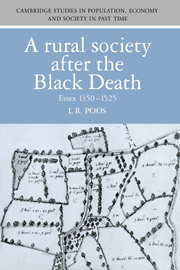Book contents
- Frontmatter
- Contents
- List of figures
- List of tables
- Preface
- Abbreviations
- Part I Reflections on a transitional era
- Part II ‘Country-dwellers, common folk and craftsmen’
- Part III ‘The total sum of all persons’
- 5 Population aggregates over time
- 6 Components of demographic equilibrium
- Part IV ‘While it is so forward between us’
- Part V ‘She came that day seeking service’
- Part VI ‘Beware of such holy men’
- Part VII Synthesis
- Bibliography
- Index
- Cambridge Studies in Population, Economy and Society in Past Time 18
5 - Population aggregates over time
Published online by Cambridge University Press: 14 September 2009
- Frontmatter
- Contents
- List of figures
- List of tables
- Preface
- Abbreviations
- Part I Reflections on a transitional era
- Part II ‘Country-dwellers, common folk and craftsmen’
- Part III ‘The total sum of all persons’
- 5 Population aggregates over time
- 6 Components of demographic equilibrium
- Part IV ‘While it is so forward between us’
- Part V ‘She came that day seeking service’
- Part VI ‘Beware of such holy men’
- Part VII Synthesis
- Bibliography
- Index
- Cambridge Studies in Population, Economy and Society in Past Time 18
Summary
The central and northern district of Essex is unique in that it affords a large volume of data for aggregate population change between the late 1200s and the sixteenth century. This evidence comes from the annual totals of resident adolescent and adult males in sixteen communities, provided by the frankpledge system administered through leet and manorial courts. The tithing data have the advantages of being based explicitly upon residence, rather than the tenure or tax payment that forms the basis of the great majority of medieval documents upon which population estimates are usually based, and of extending over a lengthy period and over a number of communities of varying sizes, types and administrative lordships. The near-unanimity of the patterns that these data reveal, and the ways in which the data can be cross-checked at various points with other local sources to verify their credibility as accurate reflections of local populations, indicate that for this district at least the course of aggregate change can be recovered with considerable confidence.
Legal and administrative aspects of frankpledge as a basic element of local jurisdiction in medieval England have been studied reasonably fully. As early as the tenth or eleventh century, rudimentary functions of policing and providing surety for good conduct were vested in small groups, or tithings, within townships. After the Norman Conquest, certain local jurisdictional franchises came into the hands of baronial or lesser landlords; in many townships, annual or semi-annual ‘views’ of frankpledge (where the memberships of tithings were reviewed and new members enrolled) were thereby fused with jurisdiction over minor criminal offences, public nuisances, and infractions against the assises of bread and ale exercised by manorial lords in leet courts, whereas elsewhere these matters might remain within the purview of the sheriff's tourn.
- Type
- Chapter
- Information
- A Rural Society after the Black DeathEssex 1350–1525, pp. 91 - 110Publisher: Cambridge University PressPrint publication year: 1991



